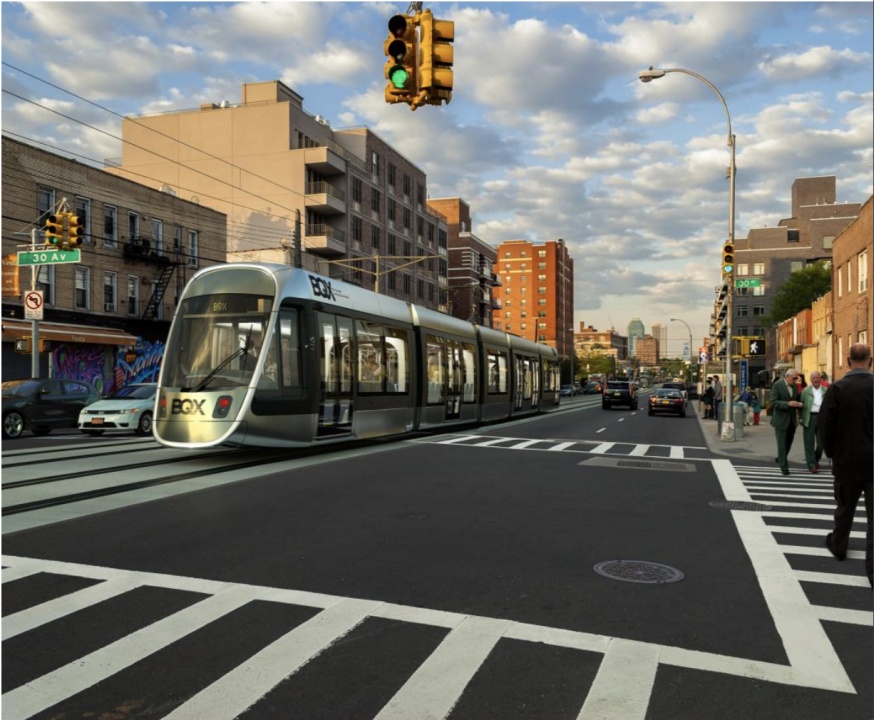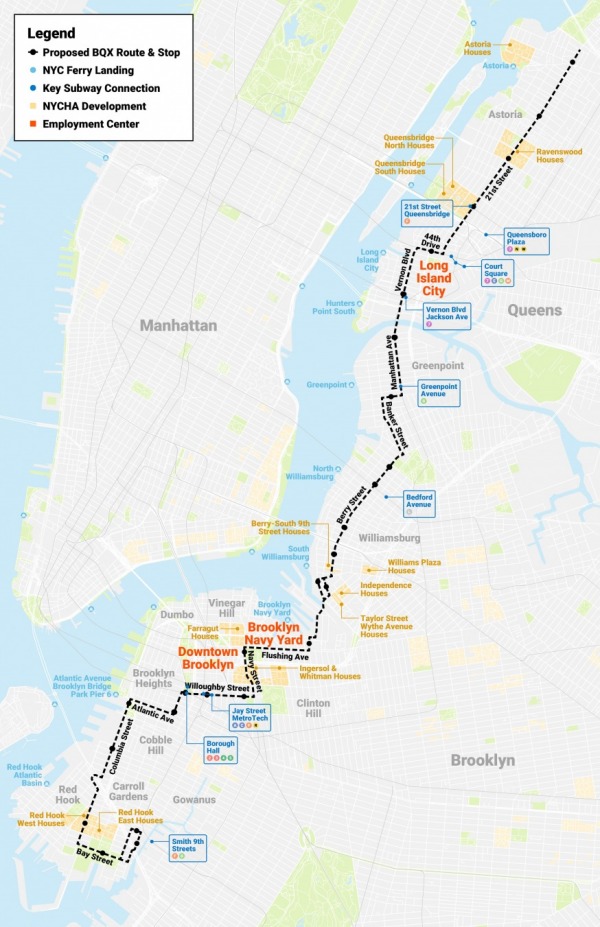
BQX Rending on 21st Street in Astoria (EDC+DOT)
May 4, 2020 By Allie Griffin
The future of the $2.7 billion streetcar connecting western Queens to northwest Brooklyn remains uncertain, as the city now grapples with a massive budget hole brought on by COVID-19.
The city had just begun the environmental review process for the streetcar project, dubbed the BQX, in February and March — but the project could now be delayed or event halted altogether, as the city budget is projected to lose $7.4 billion in tax revenue.
Mayor Bill de Blasio said last week that he was unsure whether the new budget could support the project.

Proposed BQX Route (EDC+DOT)
“It’s a very good example of the kind of thing that now has to be thought of very differently simply for the budget ramifications alone,” he said at a City Hall briefing last week.
He declined to give a firm answer as to whether or not the BQX will still happen — and noted that “substantial federal funding” was needed to make the project a reality.
The city needs the federal government to cover half the cost of building the 11-mile streetcar line.
However, the city is already asking the federal government to send coronavirus relief money to cover the massive budget gap.
The NYC Economic Development Corporation (EDC) has yet to disclose what its next steps are with the BQX.
It had planned to begin scoping for the project this month but no public meetings have been scheduled, according to the project website.
The BQX streetcar, which was first announced by Mayor Bill de Blasio in 2016, would connect Astoria, Queens to Red Hook, Brooklyn.
3 Comments







The original completion date has already slipped five years from 2024 to 2029. There is no guarantee that the Federal Transit Administration will pay for up to 50% of the cost. Dreams of Amazon doing the same have come and gone, since they canceled coming to Long Island City. There is no funding for this project in the MTA $51 billion 2020 – 2024 Five Year Capital Plan. There is no commitment to use future Manhattan congestion pricing toll revenues starting in 2021 to help fund this project. It remains to be seen if this project will be included within the pending long range MTA 2020 – 2040 Capital Needs Assessment Plan document. There is no proposed funding to advance this project in either the city or state budgets. No one knows if the next Mayor will support this project and make it a priority. The same would be true for the next NYC Economic Development Corporation President or NYC Department of Transportation Commissioner. Mayor Bill de Blasio has yet to request approval to enter the Federal Transit Administration New Starts process for future funding. The project is not included within the February 2020 FTA New Starts report for federal fiscal year 2021. Don’t count on seeing it in the next FTA New Starts report for federal fiscal year 2022. Successful completion of this process averages five years before there is an approved Federal Full Funding Grant Agreement in place.
Mayor de Blasio’s plan to finance this project by taking a percentage of property taxes (value capture) on new development was always robbing Peter to pay Paul. This would reduce the amount of money available for police, fire, sanitation and other essential municipal services. Both the NYC DOT and Economic Development Corporation have no experience in design, construction or operations of street car systems. Mayor de Blasio will have to ask the MTA to serve as a project sponsor and system operator. The MTA, not wanting to use its own funding, would have to enter the project into the FTA New Starts program. MTA, NYC DOT, Port Authority of NY and NJ, NJ Transit and Amtrak are all attempting to qualify many other projects for the same federal New Starts program.
Completion of a planning study is just the first step of any potential capital transportation project improvement. The journey for a project of this scope can easily take 10 to 20 years before becoming a reality. Given the increasing uncertainties of project financing and growing costs for utility, sewer lines and water main relocation, a new limited stop bus route along this corridor would make more sense. Reducing head ways and adding equipment to the Brooklyn/Queens Crosstown NYC Transit subway G line which runs in close proximity along the same corridor could quickly be implemented. All this would take is reallocation of several dozen subway cars out of a 6,000 plus fleet. Without a billion or more from Washington, don’t count on riding the Brooklyn Queens Connector in your life time. Instead, try running simple limited stop bus service on the same route. The ongoing MTA NYC Transit Queens Bus Network Redesign Draft Plan proposes creation of the new QT 1 bus route. It would cross the Pulaski Bridge to connect Astoria, Long Island City, Greenpoint, Williamsburg, the Brooklyn Navy Yard, and downtown Brooklyn. This might make for a low cost easy to implement improvement rather than the $2.7 billion Brooklyn/Queens Street Car Connector.
(Larry Penner — transportation advocate, historian and writer who previously worked 31 years for the Federal Transit Administration Region 2 NY Office. This included the development, review, approval and oversight for grants supporting billions in capital projects and programs on behalf of the MTA NYC Transit bus and subway, NYC DOT Staten Island Ferry & private franchised bus operators along with 30 other transit agencies in NY & NJ)
.
I’m all for additional transit options, especially nonstop between Queens-Brooklyn. But this just seemed like a giant boondoggle.
There are already 3 bus routes that run along the BQX route (Q100, B57, B62). The most sensible thing to do, in my opinion, would have been to enhance these routes and turn it into a proper BRT route (not SBS – though that still would’ve been a step up). The plan for the BQX was to create dedicated lanes so why not just give that to the bus routes? This would allow them to really cruise through traffic and have positive effects for everyone who rides the bus, including existing Q100 riders or people commuting into Manhattan.
Given the existing bus routes, all that would be needed is to connect them, create the bus lanes and improve existing bus infrastructure (which can still be used by local bus routes). This part of Astoria is lacking any real transit infrastructure so why not create a subway-like experience for these residents?
For anyone curious what a BRT would look like, check this out: https://www.cleveland.com/news/erry-2018/11/149927818e3851/rta-says-healthline-had-10year.html
BQX Ain’t gonna happen.